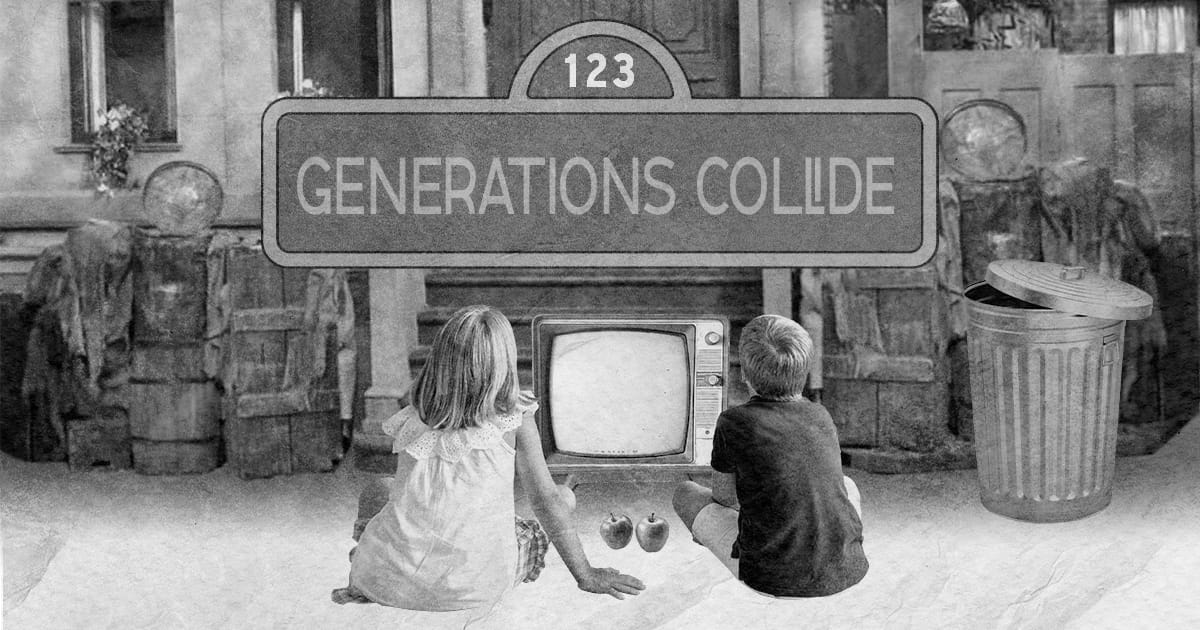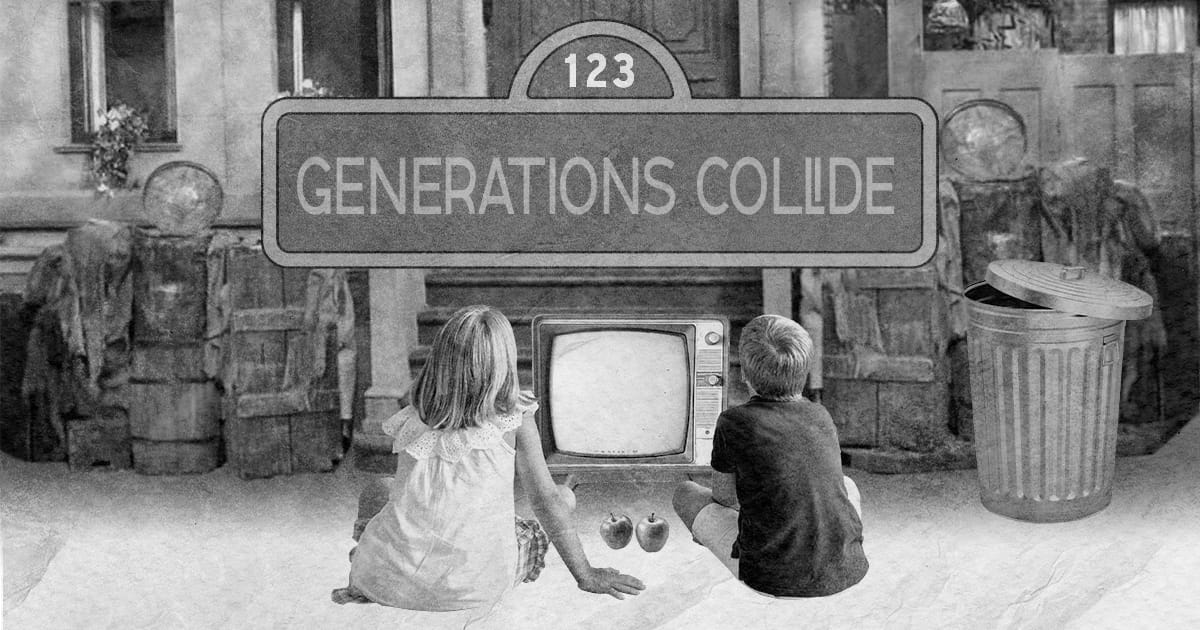- Collide - Generational Leadership
- Posts
- Elmo, Can You Tell Me How to Get... Across Generations?
Elmo, Can You Tell Me How to Get... Across Generations?
How Sesame Street Became a Cultural Bridge from Gen X to Gen Alpha and Why Netflix Bought It


I didn’t grow up with cable. On a good day, depending on the antenna (okay, maybe not quite as far back as the bunny ears era), we had only a handful of channels. One of them was PBS. I remember occasionally seeing Bob Ross painting a masterpiece. And I vividly remember the Bronx-inspired brownstones on Sesame Street.
Recent headlines about Sesame Street moving to Netflix brought me back to that brown plaid couch of the 90s in my basement, with eyes glued to that square-ish, arched glass-faced behemoth of a machine we called a TV. It’s not because I watched it every day. In fact, I wasn’t allowed to watch TV on school nights. But the recent headlines revealed a much larger impact, a generational shift. One that has been unfolding for 6 decades.
This isn’t just about a licensing agreement or content library migration. It’s a generational moment. A cultural signal. And if you’re a business leader, it should make you ask a deeper question: What shaped the people you lead? And what’s shaping the ones who will replace them?

Netflix Didn’t Just Buy a Show.
The Netflix deal gives Sesame Street access to more than 300 million global subscribers, ensuring the show’s longevity amid federal funding cuts to PBS and NPR (Liang, 2023). That might sound like a win for streaming platforms, but it’s more than that. Sesame Street has always been a kind of cultural mirror reflecting who we are, what we value, and what we teach our kids about the world they’ll inherit.
Creators Joan Ganz Cooney and Lloyd Morrisett, members of the Silent Generation, launched the show in 1969 from a radical idea: what if television could be used to close the early education gap for underserved children (Greene, 2019)?
In its first season, Sesame Street featured a racially integrated cast—unheard of in mainstream children’s television. In fact, just 6 months after the first episode aired, the state of Mississippi briefly banned the show for having an “integrated cast of children”("Mississippi agency votes," 1970). But that didn’t stop its creators. They believed children needed to see diversity, empathy, and equity modeled on screen. They believed television could teach more than letters and numbers. It could teach values. It could shape the next generation.
And it did.
Generation X Learned to Count—and to Coexist
Gen Xers were among the first kids to grow up with Sesame Street. By the late 1970s, more than nine million children under age six watched the show daily (Kearney & Levine, 2019). These would have been all Gen Xers. These were the latchkey kids. The ones who came home to quiet houses and glowing screens. Big Bird, Gordon, Maria, and Cookie Monster weren’t just characters on those screens. They were mentors, companions, and teachers.
And what were they teaching? Not just counting and spelling. They were modeling respect, self-regulation, and cooperation. They shared blocks, took turns, and helped a friend feel heard. These weren’t just life skills; they were leadership traits being seeded.
⭐️ This is the part we often miss as leaders. We forget that what happens on the playground or the living room floor doesn’t just stay there. It follows us. How we were disciplined, encouraged, protected, or ignored as children forms the foundation of how we operate in the workplace. Whether we speak up in meetings. Whether we expect a trophy for showing up. Whether we coddle or criticize our teammates.
If you want to understand a generation, don’t just look at their LinkedIn profile. Look at their childhood media and their upbringing. Understand what influenced them in their most foundational and formative years.
Stay up-to-date with AI
The Rundown is the most trusted AI newsletter in the world, with 1,000,000+ readers and exclusive interviews with AI leaders like Mark Zuckerberg, Demis Hassibis, Mustafa Suleyman, and more.
Their expert research team spends all day learning what’s new in AI and talking with industry experts, then distills the most important developments into one free email every morning.
Plus, complete the quiz after signing up and they’ll recommend the best AI tools, guides, and courses – tailored to your needs.
Every Generation Reacts to the One Before
Here’s where the pendulum swings.
Silent Generation creators, shaped by war, discipline, and order, dreamed of a better, fairer world. Baby Boomers rebelled against institutions, demanding equality and peace. Generation X became independent, skeptical, and self-reliant. Millennials were raised to be affirmed and protected—products of the self-esteem movement. Gen Z? Digital natives with anxiety but empathy, fluency but fatigue. Gen Alpha, from what we can tell so far, is experiencing a swing back towards a simpler, more primitive childhood in the home despite the fact that there is more chaos and commotion outside their houses.
You can trace every one of these generational behaviors back to early childhood cues. You can also trace the counter-behaviors. Because each generation doesn’t just build on the last—they often swing in reaction to it. It’s why the “woke” Gen Z worldview makes some Boomers roll their eyes—and why some Gen Zers see Boomers as cold and callous. It’s all connected.
If Sesame Street taught us anything, it’s that even small, consistent messages—like a song about sharing—can influence an entire generation’s worldview.
So yes, this Netflix deal is a big business move. But it’s also a symbolic moment: a reminder that shaping minds isn’t just about what we do at work. It’s about what we teach when we think no one’s watching. It’s about the stories we tell our children. The songs we let them sing. The characters we let them follow.
A Show Shaped by the Pillars of Culture
What makes Sesame Street such a powerful generational indicator is that it touches every one of the seven cultural pillars I use when analyzing societal change: Religion, Economics, Sex/Gender, Politics, Education, Communication, and Technology.
Religion: While rarely addressed directly, Sesame Street promoted universal moral principles—kindness, compassion, honesty—that reflected the Judeo-Christian ethic without proselytizing. It made moral formation accessible to secular and religious households alike.
Economics: The show was born from Lyndon Johnson’s “War on Poverty,” funded by public broadcasting dollars to bridge the educational gap for low-income children. Later, its positive effects on long-term earnings and graduation rates became well-documented (Kearney & Levine, 2019).
Sex/Gender: From adding more female Muppets to introducing Julia (a character with autism) and two dads raising a child, the show evolved with the times. It responded to the culture’s questions with courage, often before society caught up (Firozi, 2021).
Politics: Sesame Street has always walked the line. When Ted Cruz called Big Bird’s COVID vaccine tweet “government propaganda,” it reminded us that even puppets aren’t safe from partisanship (Salam, 2021). But the show itself has remained rooted in equity, not ideology.
Education: The core mission never changed: prepare every child, especially the disadvantaged, for kindergarten. And it worked. Research shows children who watched Sesame Street were 14% more likely to be at grade level in school by age seven (Kearney & Levine, 2019).
Communication: From broadcast TV to YouTube, from Elmo’s World to Elmo’s Twitter feed, Sesame Street has innovated across every major shift in media consumption.
Technology: Whether it was introducing STEM topics in skits or showing how computers work, Sesame prepared children not just for school—but for a world increasingly driven by tech.
In other words, Sesame Street didn’t just keep up with the times. It shaped the times. And now, through Netflix, it’s about to shape the next generation all over again.
The Lessons Follow Us from Sesame Street to Wall Street
As leaders, we often spend so much time reacting to generational behaviors—why Gen Z won’t stay in jobs, why Millennials need constant feedback, why Boomers resist change—that we forget to ask what formed them in the first place. Oh, and we so often forget to talk about Gen X in generational conversations.
If we want to lead better, we need to look back. Not just at their resumes, but at their roots.
Because somewhere, long before they sat across from you in a strategy meeting, they sat cross-legged on the floor watching Elmo teach them how to name their feelings. Or Oscar the Grouch show them how to disagree without destroying a relationship.
That’s not just nostalgia. That’s formation.
And now that Netflix is taking up the mantle, one thing is certain: The street goes on. And so do the lessons.
Generations…In The Media
Thank you for reading!
Until next time,

Works Cited
Firozi, P. (2021, June 21). Family with two dads debuts on ‘Sesame Street’ during Pride Week. The Washington Post. https://www.washingtonpost.com/arts-entertainment/2021/06/21/sesame-street-pride-month-episode/
Greene, B. (2023, July 27). The Unmistakable Black Roots of ‘Sesame Street’. Smithsonian Magazine. https://www.smithsonianmag.com/history/unmistakable-black-roots-sesame-street-180973490/
Kearney, M. S., & Levine, P. B. (2019). Early childhood education by television: Lessons from Sesame Street. American Economic Journal: Applied Economics, 11(1), 208–235. https://doi.org/10.1257/app.20170300
Liang, A. (2023, September 18). Sesame Street heads to Netflix after Trump pulled funding. BBC News. https://www.bbc.com/news/articles/c80k7z8z77yo
Mississippi Agency Votes for a TV Ban on 'Sesame Street'. (1970, May 3). The New York Times. https://www.nytimes.com/1970/05/03/archives/mississippi-agency-votes-for-a-tv-ban-on-sesame-street.html
Salam, E. (2021, November 9). “They’re puppets!”: Why the US right loves to hate Sesame Street. The Guardian. https://www.theguardian.com/tv-and-radio/2021/nov/09/sesame-street-ted-cruz-republicans-big-bird-vaccine





Reply